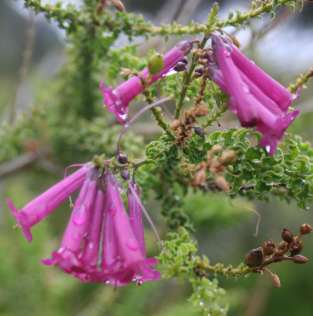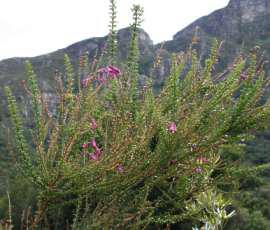Freylinia crispa
Freylinia crispa Van Jaarsv.
Family: Scrophulariaceae
Common names: Kouga bell-bush (Eng.); Kouga klokkiesbos (Afr.)
Introduction
The attractive purple flowers of the Kouga bell-bush will brighten up your garden.

Description
Description
Freylinia crispa is an erect, slender shrub, which grows up to 2.5 m high. The leaves are ovate with the leaf margins slightly thickened and crisped. The subpendulous flowers are purple. The shrub flowers from autumn until spring (April to October).

Conservation Status
Status
Freylinia crispa is currently Red Listed as Vulnerable (VU). It is a Rare species and a range-restricted endemic that is known from only two sites in the Kouga Valley. Although its population is stable it is potentially threatened by invasive alien plants.
Distribution and habitat
Distribution description
Freylinia crispa is found in the Kouga Valley near Brandhoek in the Joubertina District. The shrub grows in sunny, well-drained, steep, east-facing rocky sandstone scree in dry fynbos.
Derivation of name and historical aspects
History
The genus Freylinia was named after Count L. Freylino who owned a well-known garden in Italy in the 19th century. The species name crispa refers to the irregular wavy edge of the leaves. There are also nine other species of Freylinia in South Africa of which F. tropica, F. lanceolata, F. densiflora and F. undulata make beautiful garden plants.
Ecology
Ecology
The seed capsules of the plant ripen from early summer and split open, releasing flat, winged seeds, which are dispersed by wind. It also has rhizomes from which it resprouts and produces small suckers. This is another way of ensuring its survival in the veld, particularly after fire or being grazed.
Uses
Use
No cultural uses have been recorded, but it makes and intersting garden plant.

Growing Freylinia crispa
Grow
Freylinia crispa is grown easily from cuttings. Take soft wood to semi-mature, short cuttings in autumn, spring or summer. These cuttings can be treated with a rooting hormone to help stimulate rooting. They will root within a month. Once the cuttings have rooted, place them in a slightly shaded area to harden off for three weeks before potting. Pot in a well-drained soil mix and place under a shade net until ready for planting. Propagation from seed has not yet been tried.
The Kouga bell-bush is an ideal plant for any fynbos garden and will make an excellent water-wise garden plant in the winter-rainfall region. It will grow particularly well in well-drained loamy soils and will do well in a warm sunny spot or a lightly shaded area in your garden. The plant grows tall and vigorously so it can be planted as a screen to hide any structures or walls and can also be planted at the back of a bed with smaller shrubs and herbaceous perennials growing in front of it. Regular pruning will keep the bush nice and tidy. The bright purple flowers attract birds to the bush and it is ideal for attracting birds to the garden.
References
- Goldblatt, P. & Manning, J. 2000. Cape Plants. A conspectus of the Cape flora of South Africa. Strelitzia 9. National Botanical Institute, Pretoria & Missouri Botanical Garden, Missouri.
- Hyam, R. & Pankhurst, R. 1995. Plants and their names: a concise Dictionary. Oxford University Press Inc., New York.
- Van Jaarsveld, E. 1990-1991. Freylinia crispa. Flowering Plants of Africa 51: pl 2033. National Botanical Institute, Pretoria.
- Van Jaarsveld, E. & Raimondo, D. 2005. Freylinia crispa Van Jaarsv. National Assessment: Red List of South African Plants version 2015.1. Accessed on 2016/03/15
Credits
Trevor Adams
Kirstenbosch NBG
November 2007
Conservation status updated in March 2016
Plant Attributes:
Plant Type: Shrub
SA Distribution: Eastern Cape
Soil type: Sandy, Loam
Flowering season: Spring, Winter
PH: Acid, Neutral
Flower colour: Purple
Aspect: Full Sun, Morning Sun (Semi Shade)
Gardening skill: Challenging
Special Features:
Horticultural zones









Rate this article
Article well written and informative
Rate this plant
Is this an interesting plant?
Login to add your Comment
Back to topNot registered yet? Click here to register.